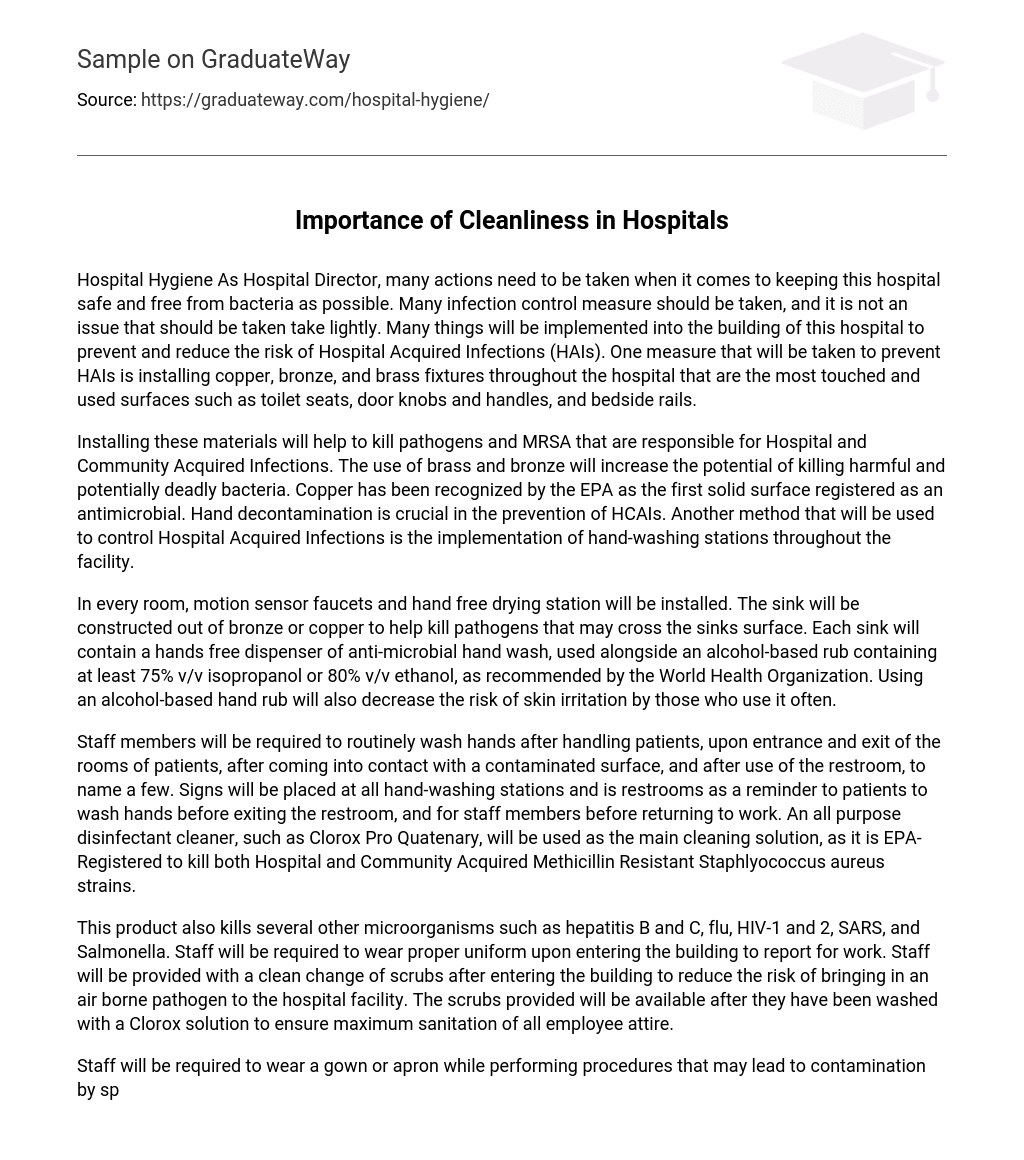Hospital Hygiene As Hospital Director, many actions need to be taken when it comes to keeping this hospital safe and free from bacteria as possible. Many infection control measure should be taken, and it is not an issue that should be taken take lightly. Many things will be implemented into the building of this hospital to prevent and reduce the risk of Hospital Acquired Infections (HAIs). One measure that will be taken to prevent HAIs is installing copper, bronze, and brass fixtures throughout the hospital that are the most touched and used surfaces such as toilet seats, door knobs and handles, and bedside rails.
Installing these materials will help to kill pathogens and MRSA that are responsible for Hospital and Community Acquired Infections. The use of brass and bronze will increase the potential of killing harmful and potentially deadly bacteria. Copper has been recognized by the EPA as the first solid surface registered as an antimicrobial. Hand decontamination is crucial in the prevention of HCAIs. Another method that will be used to control Hospital Acquired Infections is the implementation of hand-washing stations throughout the facility.
In every room, motion sensor faucets and hand free drying station will be installed. The sink will be constructed out of bronze or copper to help kill pathogens that may cross the sinks surface. Each sink will contain a hands free dispenser of anti-microbial hand wash, used alongside an alcohol-based rub containing at least 75% v/v isopropanol or 80% v/v ethanol, as recommended by the World Health Organization. Using an alcohol-based hand rub will also decrease the risk of skin irritation by those who use it often.
Staff members will be required to routinely wash hands after handling patients, upon entrance and exit of the rooms of patients, after coming into contact with a contaminated surface, and after use of the restroom, to name a few. Signs will be placed at all hand-washing stations and is restrooms as a reminder to patients to wash hands before exiting the restroom, and for staff members before returning to work. An all purpose disinfectant cleaner, such as Clorox Pro Quatenary, will be used as the main cleaning solution, as it is EPA-Registered to kill both Hospital and Community Acquired Methicillin Resistant Staphlyococcus aureus strains.
This product also kills several other microorganisms such as hepatitis B and C, flu, HIV-1 and 2, SARS, and Salmonella. Staff will be required to wear proper uniform upon entering the building to report for work. Staff will be provided with a clean change of scrubs after entering the building to reduce the risk of bringing in an air borne pathogen to the hospital facility. The scrubs provided will be available after they have been washed with a Clorox solution to ensure maximum sanitation of all employee attire.
Staff will be required to wear a gown or apron while performing procedures that may lead to contamination by splashing blood, excretions, secretions, and body fluid on the clothing to reduce the transmission of microbes. In the event that this does happen, said staff member will be required to change into new set of scrubs after finishing the procedure after immediately washing hands with provided soaps and rubs. Strict cleaning regimens of hospital rooms, bathrooms, and all other areas accessed by medical staff and patients will be mandatory.
Cleaning crews and custodians will receive extensive training in how to handle hazardous waste, as well as cleaning chemicals, and how to avoid cross contamination. An adequate disinfectant, such as hypochlorite, which reduces the incidence of Clostridium difficle infection, will be provided for use by the cleaning crew. The use of latex gloves will be required by all stuff when performing duties that may involve contamination of germs, blood, or bodily fluids. Although germs are not completely avoidable, I will do my best at this facility to reduce Hospital Acquired Infections.
Many methods will be implemented to maintain a safe and sterile environment. This hospital will maintain superior safety measures and clean practices to prevent any unwanted spreading of infections. Works Cited Kramer, A. et al (2002) Limited efficacy of alcohol-based hand gels. Lancet; 359: 1489-1490. Barker, J. et al (2004) Effects of cleaning and disinfection in reducing the spread of Norovirus contamination via environmental surfaces. Journal of Hospital Infection: 58: 42-49. Hospital Hygiene, Raising Awareness. Web. Accessed March 20, 2013.





